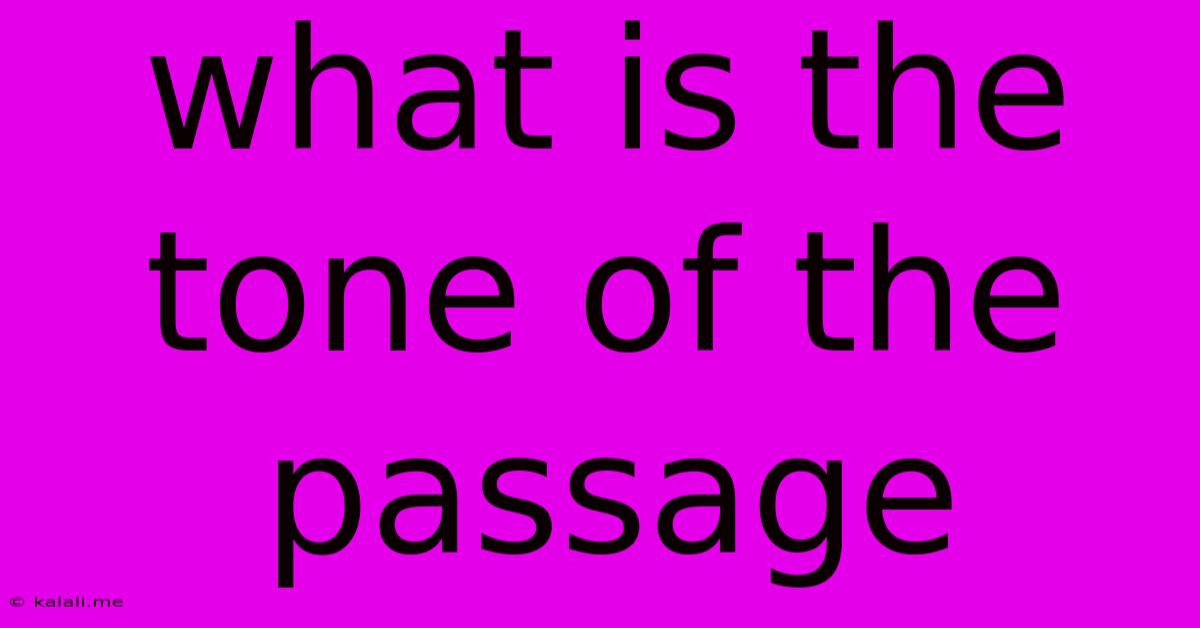What Is The Tone Of The Passage
Kalali
Jun 13, 2025 · 3 min read

Table of Contents
Deciphering the Tone of a Passage: A Guide for Writers and Readers
Determining the tone of a passage is crucial for both writers and readers. For writers, understanding tone allows for precise communication of intended meaning and emotional impact. For readers, identifying tone helps in accurately interpreting the author's message and fully appreciating the text's nuances. This article explores what tone is, how to identify it, and provides examples to illustrate various tonal possibilities.
What is Tone?
Tone in writing refers to the author's attitude towards the subject matter and the audience. It's the emotional coloring of the text, the feeling it evokes in the reader. Think of it as the author's "voice" – their personality and approach shining through the words. Unlike mood, which is the feeling created in the reader, tone is the feeling conveyed by the author. A passage can have a serious mood, but a playful tone.
Identifying Tone: Key Elements to Consider
Several elements contribute to a passage's overall tone. By analyzing these, you can effectively pinpoint the author's intended effect:
-
Word Choice (Diction): The specific words used significantly impact tone. Formal language creates a sophisticated tone, while informal language can be casual or even humorous. The use of strong verbs and vivid adjectives creates a more powerful and dramatic tone, whereas weaker verbs and bland adjectives result in a more subdued tone.
-
Sentence Structure: Short, choppy sentences often suggest urgency or excitement, while long, complex sentences can convey a more formal, thoughtful, or even ponderous tone.
-
Figurative Language: Metaphors, similes, and other figures of speech contribute to the emotional impact and overall tone. Irony, sarcasm, and hyperbole can create a humorous, cynical, or satirical tone.
-
Imagery: The sensory details used can evoke specific emotions and contribute to the overall tone. Detailed descriptions of gloomy weather might suggest a melancholic tone, while vivid descriptions of vibrant colors and lively sounds could create a joyful or celebratory tone.
-
Purpose: Understanding the author's purpose – to inform, persuade, entertain, or evoke emotion – greatly assists in identifying the tone. A persuasive piece might have a passionate or authoritative tone, while an informative piece might adopt a neutral or objective tone.
Examples of Different Tones:
Let's examine how different tones manifest in brief examples:
-
Humorous: "The cat, a fluffy terror disguised as a lap cat, decided my freshly ironed shirt was the perfect place for a nap." (Informal language, playful imagery)
-
Formal: "The aforementioned proposition requires meticulous consideration prior to implementation." (Formal diction, complex sentence structure)
-
Nostalgic: "The old carousel, painted with faded hues of rose and gold, creaked gently as it turned, bringing back a flood of childhood memories." (Sensory details, emotional language)
-
Sarcastic: "Oh, fantastic, another meeting. Just what I needed on a Friday afternoon." (Irony, informal language)
-
Objective: "The experiment yielded inconclusive results, requiring further investigation." (Neutral language, factual reporting)
Conclusion:
Mastering the art of identifying and utilizing tone is essential for effective communication. By carefully analyzing word choice, sentence structure, figurative language, and imagery, readers can better understand the author's message. Similarly, writers can leverage these elements to craft precisely the tone needed to connect with their audience and achieve their writing goals. Pay close attention to the details, and you'll be well on your way to deciphering the unspoken emotions embedded within any passage.
Latest Posts
Latest Posts
-
Good Words To Describe Your Mom
Jun 14, 2025
-
Essentially The Output Of Aggregate Planning Is The
Jun 14, 2025
-
Which Of The Following Statements About Gender Is True
Jun 14, 2025
-
The Underlined Part Of The Sentence Is A
Jun 14, 2025
-
What Is A Factor Of 95
Jun 14, 2025
Related Post
Thank you for visiting our website which covers about What Is The Tone Of The Passage . We hope the information provided has been useful to you. Feel free to contact us if you have any questions or need further assistance. See you next time and don't miss to bookmark.